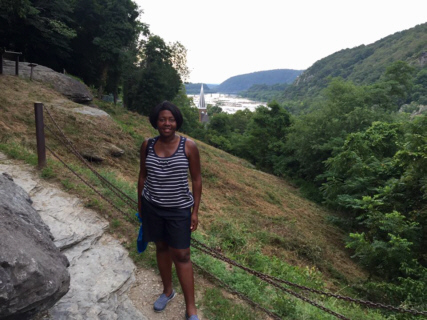
Road Trip Across Washington
Monday was my favorite day of our Washington trip. It was the day we drove across the state. Our unexpected experiences in the towns of Vantage and Leavenworth were highlights.
Our day started early with a hearty breakfast at Perkins across the street from our hotel. We then took the hotel's complimentary shuttle to the airport where we picked up our rental car - a red Volkswagen Jetta. Our plan was to drive from Spokane located on the east side of the state to our next hotel in Chehalis located on the west side of the state. This is about a 5-hour drive. I knew it would be much longer for us because I had planned to stop at some of the attractions listed in my AAA tour book along the way.
I brought my GPS navigation unit (nicknamed "The Navi") from home. It had us driving west on highway I-90 to get to our first planned stop. By the way, I-90 is the longest interstate in the U.S.. You can drive this highway from Boston, Massachusetts to Seattle, Washington.

Columbia River Scenic Overlook on I-90 West
The diverse landscape of Washington was a surprise to me. Shortly after leaving Spokane, we were driving through mostly farmland. As we approached our first planned stop about 2 hours into the trip, we found ourselves riding through a desert landscape.
Our first stop was just off I-90 in the town of Vantage. We were there to visit Ginkgo Petrified Forest State Park. A petrified forest is a term used to describe an area containing wood that has turned to stone (petrified wood). The process of turning wood to stone normally takes millions of years. The process begins after the wood becomes trapped in a situation that slows down its decay process. The petrified wood often contains sparkling crystals resulting from the minerals absorbed into the decaying cells. There are several petrified forests around the world. In 2001, Traci and I visited the Petrified Forest in Arizona and found it fascinating. Therefore, I was looking forward to checking out the one in Vantage.
We stopped by the Ginkgo Interpretive Center for some information on the park and to buy a one-day Discover Pass. The pass cost $10 per vehicle. The fine for being in the park without one is $99! The nice lady behind the counter of the interpretive center was enthusiastic about sharing information about the park and its surrounding area. During our conversation, I mentioned that there was no soap in the restroom. She told me the funding for the state parks has been reduced so much that they can't afford to keep soap in the restrooms anymore. Ewww! Traci and I normally bring Wet Naps with us when we travel in case we find ourselves in situations such as this but we had misplaced them. Fortunately, the nice lady loaned me her bottle of hand sanitizer she kept behind the counter. This soap situation became my running joke for the rest of the trip. Whenever I came out of a park's restroom, I would tell Traci that this must be a national park because there is soap in the restroom. Corny. I know.
There was only one other visitor in the interpretive center at the time Traci and I were there. The three of us were invited into the small theater to watch a 15-minute film on the formation and discovery of the petrified wood in Ginkgo. The film pointed out two things that make Ginkgo unique among other petrified forests. First, it is believed the wood in Ginkgo became petrified as a result of getting trapped in cooling lava. Second, the park contains petrified wood of the extinct ginkgo tree.
We looked at some of the petrified logs that were on display outside the interpretive center. We could see the crystals inside them. We tapped on the logs and, sure enough, they were as hard as stone. The lady at the interpretive center told us there was a paved trail about two miles up the road where we could see petrified wood specimens in the environment where they were discovered. She also warned us to watch out for rattlesnakes. She was not sure what was different about this year, but reported snake encounters were up sharply. She said we were not likely to see one in the heat of the day unless we went looking under rocks. I love to see animals in their natural environment (from a distance) but I certainly was not going to go looking for them. Traci had no desire to see any animals.

petrified log - Yup! It's hard as stone.
We decided to make the 2-mile drive so that we could walk the trail. The trail was a not too impressive. In order to protect the specimens from vandals, cages were placed around the petrified stumps. There was a cage every few yards and a sign indicating the type of tree stump it contained. The first three caged stumps looked the same to us so we turned around and went back to the car. On a positive note, the coolest part of the trail for me was the desert landscape. This is something I do not see on the east coast where I live.

trail through the petrified forest

petrified stump in a cage to prevent vandalism and theft
Although our visit to Ginkgo Petrified Forest State Park was not very exciting, some good came from chatting with the lady at the interpretive center. She told us that there was a wind farm about 10 miles up the road where we could get fairly close to the gigantic wind turbines. This sounded like an interesting diversion that would not take us too far off our planned route. A wind turbine looks like a very tall white pole that has a propeller attached to the top of it. Wind causes the propeller to spin which in turn generates electricity. As we drove over the hills of the two-laned desert road, more and more of these turbines came into view. Some propellers were spinning while others were not. It was a surreal scene. I had never been this close to these towering pillars; however, we were still not close enough to walk up to one.

lonely desert road
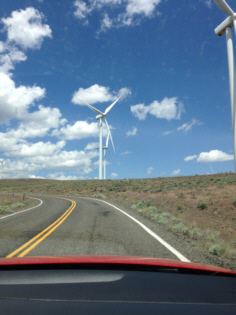
wind turbines
Thinking I had driven far enough, I was looking for somewhere to safely turn the car around when I came across the entrance to the Puget Sound Energy (PSE) Wild Horse Wind and Solar Facility. I was not sure we were supposed to be there until I saw a sign indicating the road to the visitors center. It was a 3-mile drive uphill on a curvy road to get the center. Thanks to my unfamiliarity with our rental car functions, I announced our arrival in the parking lot by accidentally setting off the car alarm - embarrassing. Traci came to my rescue and showed me how to turn it off.
The timing of our unplanned visit turned out to be fortuitous for us. Tours of the facility are given only twice per day (10 AM and 2 PM). We had arrived a half-hour before the 2 PM tour. In the meantime, Traci and I had a look at the hands-on exhibits and short film presentations explaining the process of harnessing wind and solar energy to produce electricity. We found the material to be engaging and interesting.
We were given hard hats and safety googles to wear during the tour. Our guide led us outside where he began explaining how PSE uses its wind turbines and solar panels to supply electricity to the surrounding towns. As expected, this area is quite windy. Additionally, it receives 300 days of sunshine per year which makes it a great spot for the solar panels. We learned quite a few interesting facts during the 45-minute tour. I always thought, "the windier, the better" for the turbines but this is not the case. They only produce electricity when the wind speed is between 9 and 56 m.p.h.. The propellers are stopped during any speed outside this range. I also learned that there are electronics housed at the top of the turbine that swivel and angle the propeller to get the maximum wind energy. The solar panels supply the energy needed to power these decision-making units.
Our guide also spoke about the flora and fauna of the area such as the hedgehog cactus, elk, and birds. However, the highlight for me was when he led us down the gravel path to one of the turbines. I felt so small standing next to this 220-foot tower. While our guide was talking, the wind picked up and the 130-ft long, 7-ton blades began to slice through the air with a swish sound. We could actually see the blades bending as they are turning. We were invited into the base of the tower where there is a screen to monitor the turbine. We also looked up the ladder that technicians use to climb to the top to perform maintenance. We were not allowed to climb the ladder.
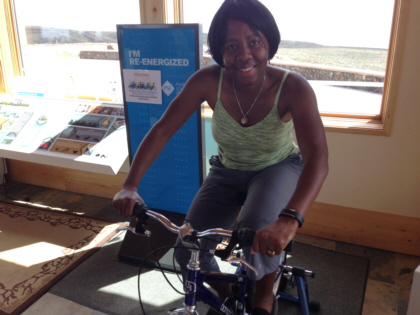
Traci generating energy

300 days of sunshine annually makes this a good location for solar panels.
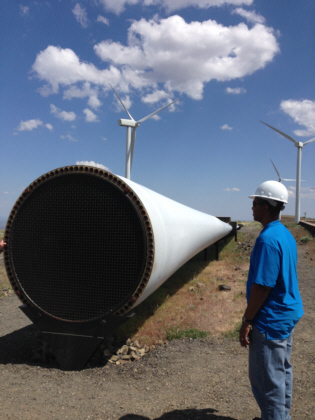
looking at one of the 130-foot turbine blades

going to check out one of the wind turbines

Let's have a look inside the tower.
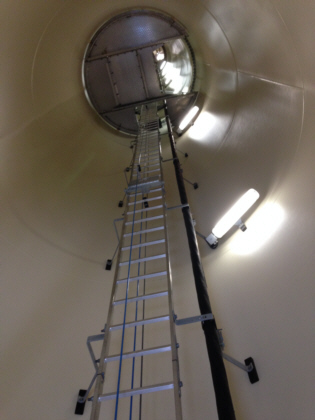
inside the wind turbine tower
The PSE Wild Horse Wind and Solar Facility was a fascinating unexpected stop but now we were at risk of not making it to our next planned stop before closing. I had chosen the Nutcracker Museum in the town of Leavenworth as our next stop on the road trip. The Navi indicated we had a 1.5-hour drive time ahead of us which would get us there 15 minutes before the museum closed. We decided to go for it anyway. I had read that Leavenworth is a Germany-themed tourist town. If we missed the museum, I figured it would be fun to walk around the town and dine at one of the restaurants.
Our drive was on a two-laned road that went through the desert, farmlands, small towns, and eventually mountainous woodlands. We arrived at the Nutcracker museum 20 minutes before closing. The admission was only $2.50/person. We were told there was no time for us to see the film that visitors see before walking through the museum. Traci and I strolled the aisles and looked at shelf after shelf of nutcrackers. We were the only visitors left at this point in the day. We met the museum owner, Mrs. Arlene Wagner. She told us that she has been collecting nutcrackers for most of her life. She was 89 years old at the time of our visit and her museum contains more than 6,000 nutcrackers. The museum has been featured in magazines and on TV programs. It was fun to see the variety nutcrackers. They were big and small. There were superheroes, politicians, cartoon characters, ordinary people, and more. The collection spans centuries and the globe. I asked Mrs. Wagner if she still comes across nutcrackers that catch her attention. She said she does and excitedly invited Traci and me back to a little room where she showed us nutcrackers she brought back from a recent trip to Europe. These were from the 18th and 19th centuries. She then allowed Traci and me to watch a 15-minute film on the history and artistry of nutcrackers while she went about closing the museum for the day. The Nutcracker Museum was a memorable stop. I'm glad we made it there in time to have a look. Its hours of operation are only 2 PM - 5 PM.



museum owner

Oh my!
Traci and I walked along Front Street, the main tourist strip of Leavenworth. Leavenworth has an interesting story. Its chief income was the logging industry until the railroad was rerouted away from the town. Rather than let the town continue to fall into despair, the townspeople decided to transform Leavenworth into a tourist destination in the 1960's. They gave their downtown a German theme. They changed the buildings to look like those of Bavarian village. The vendors dress in traditional German costumes. They even learned to speak German. The town's location at the base of the Cascade Mountains gives it an Alpine flavor. There was German music playing as Traci and I walked the streets. There were flowers in the windows. Shops, wineries, restaurants, and hotels are some of the businesses that line Front Street. The town has become a popular tourist destination - especially at Christmastime. We did not have enough time to see everything because the businesses (except the restaurants) close at 6 PM.



We perused the posted menus of the restaurants on the street. There were many enticing options. After reading several menus, we ended up back at the first restaurant we saw - The Bavarian Bistro & Bar. This was our best meal of our entire Washington trip! The food there was outstanding. Traci had a chicken dish with a vegetable medley and spaetzel. My lamb dish came with fried potatoes and brussel sprouts. I have never liked brussel sprouts but this restaurant cooked them in such a way that I thoroughly enjoyed them. It was a great meal.
As Traci and I were in the restaurant chatting about how good the meal was and about how wonderful the day had been, I happened to glance at my watch and realized it was approaching 8 PM. We still had a 3-hour drive ahead of us to get to our hotel in Chehalis, Washington. I was trying to avoid night-driving on unfamiliar roads. We gassed up and hit the road. We made it to the hotel by 11 PM. Note to self: Know how to turn on the rental car headlights before it gets dark!
Our hotel for this portion of the trip was the Best Western Plus Park Place Inn & Suites in the town of Chehalis, Washington. The Best Western was our favorite hotel of our trip. It was a moderate hotel that met our criteria for booking: free Wi-Fi, complimentary breakfast, fitness center, and points program to which Traci could use or accumulate points. We really enjoyed their waffles and Traci liked the cook-to-order omelet station. The friendly staff even remembered exactly how Traci likes her omelet prepared. The only thing we had to get used to was the freight trains that come through Chehalis. They blast their horns as they approach the town.
Aside from the criteria I listed above, I chose to stay at the Best Western in Chehalis because of its proximity to the parks we wanted to visit: Mount St. Helens National Park, Mount Rainier National Park, and Hoh Rain Forest (Olympic National Park). We had intended to stay three nights but we accidently booked only two nights online. When Traci tried to correct the mistake, the rate for the hotel in the Seattle leg of our trip had gone up $100 per night. Therefore, we decided to modify our sightseeing itinerary instead of paying extra to re-book our hotels. Continue...





